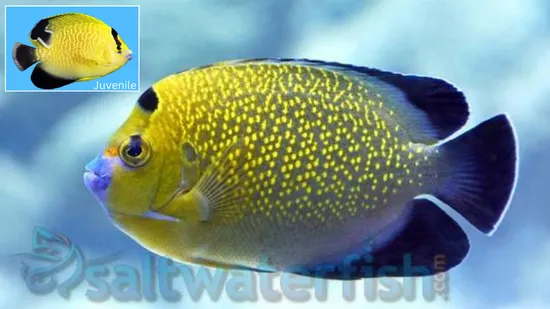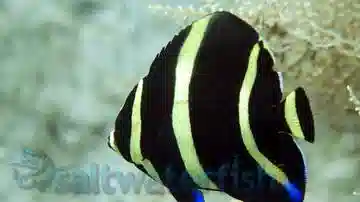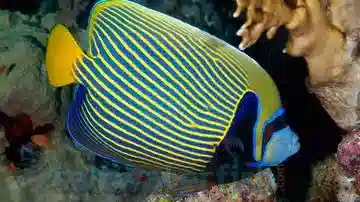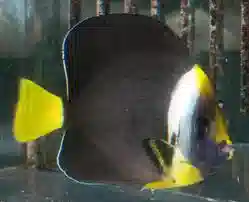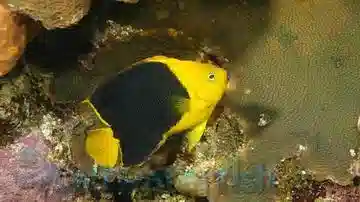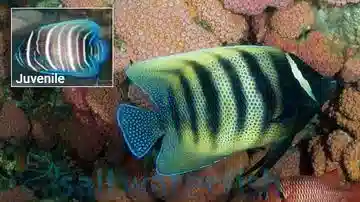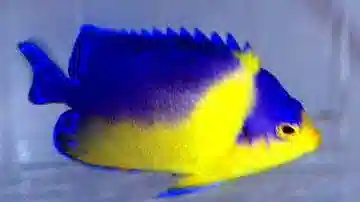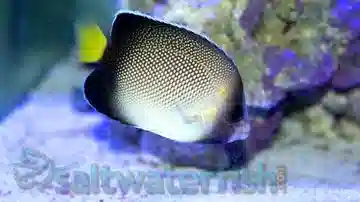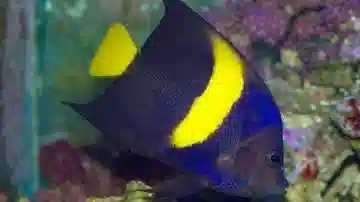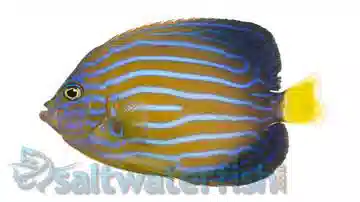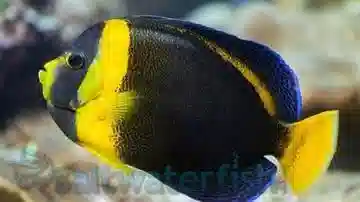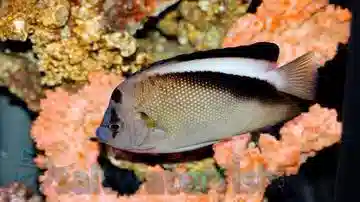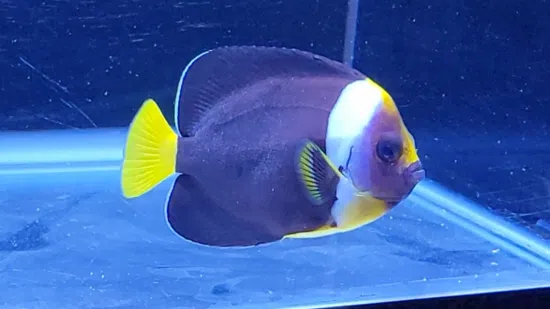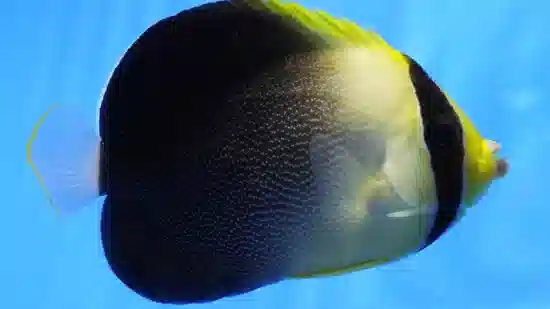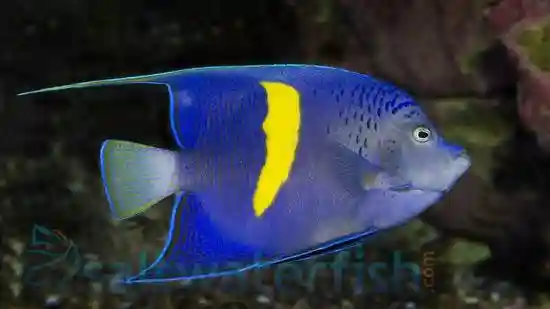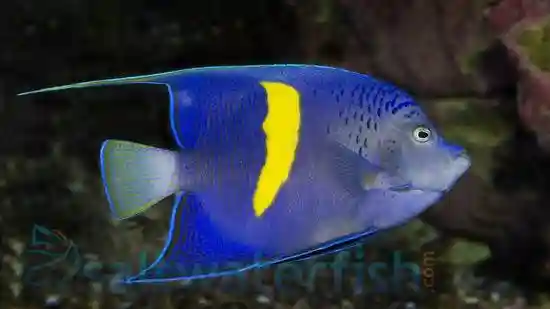Large Angelfish In Saltwater Aquariums: FAQ
Large angelfish are among the most majestic and colorful fish in the marine world. With their bold personalities, vivid coloration, and graceful movement, they can become true showpieces in a saltwater aquarium. However, large angelfish require spacious tanks, stable water conditions, and proper diet to thrive. Choosing the right species can make the difference between success and frustration.
Top large angelfish species for home aquariums:
Emperor Angelfish (Pomacanthus imperator) – One of the most iconic marine fish, known for its striking blue-and-yellow stripes and regal adult coloration. Juveniles display mesmerizing blue and white circular patterns that gradually transform as they mature. Requires 180+ gallons and a mixed diet of algae, sponge-based foods, and frozen meaty fare.
Blueface Angelfish (Pomacanthus xanthometopon) – Recognized by its electric blue “mask” and yellow body, this species is hardy and adaptable when provided with a large, stable environment. Needs 150+ gallons and thrives in fish-only-with-live-rock (FOWLR) systems.
Queen Angelfish (Holacanthus ciliaris) – A vibrant Caribbean species with iridescent blue and yellow hues. Active and assertive, it’s best for experienced aquarists with 180+ gallon tanks.
French Angelfish (Pomacanthus paru) – A hardy and personable species featuring black-and-gold coloration. Often grows large (up to 15 inches) and adapts well to captivity in tanks 200+ gallons or larger.
Majestic Angelfish (Pomacanthus navarchus) – Slightly smaller (up to 10 inches), this species is calmer and suitable for large reef-like FOWLR systems. Its vivid orange, blue, and purple coloration makes it a favorite among advanced hobbyists.
Best choices for beginners to large angels:
The Emperor, Blueface, and Majestic Angelfish are considered the most adaptable, provided the aquarium is large and stable.
One Saltwaterfish.com reviewer of the Blueface Angelfish shared: “This is a great Blueface Angelfish who showed up healthy and happy. He was shy at first in my quarantine tank but after moving him over to the main tank he has been quite the showman. Beautiful fish to add to a reef tank.”
Pro tips for success:
Provide rockwork with hiding areas and algae growth for grazing.
Avoid housing multiple large angelfish together unless the tank exceeds 250 gallons.
Feed 2–3 varied meals daily to support growth and immune health.
Bottom line: The best large angelfish species for saltwater aquariums include the Emperor, Blueface, Queen, French, and Majestic Angelfish. Each offers bold coloration and personality, but they need 150–200+ gallon systems, high water quality, and varied diets. With proper care and space, these fish can live over a decade, backed by Saltwaterfish.com’s 8-Day Live Guarantee.
Large angelfish are among the most stunning and charismatic saltwater fish, but their size often surprises new aquarists. In home aquariums, most large angelfish species grow between 10 and 15 inches, depending on the species, diet, and tank conditions. Some may grow slightly smaller than in the wild due to space and diet limitations, but they still require Tank size recommendations:
Because of their size and activity level, large angelfish require at least 150–200 gallons for a single adult. French and Queen Angelfish, which grow to the upper size range, benefit from tanks closer to 220–250 gallons. Adequate rockwork provides both territory and grazing areas, reducing stress.
Growth factors in captivity:
Diet: A balanced diet of marine algae, sponge-based foods, and meaty fare promotes steady growth.
Water quality: Stable parameters (74–78°F, pH 8.1–8.4, salinity 1.023–1.026) support long-term health.
Tank maturity: Mature systems with natural algae and biofilm encourage natural feeding behaviors and full growth potential.
One Saltwaterfish.com reviewer of the Gray Poma Angelfish shared: “I love this Grey Poma Angelfish\! Pictures don’t compare to the live fish. The new addition improves my saltwater water aquarium. Everyone loves it.”
Pro tips for healthy growth:
Feed 2–3 small, varied meals per day to mimic natural grazing.
Avoid overstocking—space competition can stunt growth.
Ensure consistent filtration and water changes to maintain pristine water quality.
Bottom line: Most large angelfish reach 10–15 inches in home aquariums. Providing a 150–250-gallon tank, high-quality diet, and stable environment allows them to grow to their full potential—becoming breathtaking centerpiece fish backed by Saltwaterfish.com’s 8-Day Live Guarantee.
Large angelfish are long-lived, intelligent marine species that can thrive for 10–15 years in captivity and in some cases even longer with proper care. Their lifespan depends heavily on tank size, diet, water quality, and overall stability. When kept in large, mature aquariums with consistent conditions, these fish can live well over a decade, rivaling their lifespans in the wild.
Typical lifespans of popular large angelfish in home aquariums:
Emperor Angelfish (Pomacanthus imperator) – 12–15 years on average, sometimes exceeding 20 in ideal conditions.
Blueface Angelfish (Pomacanthus xanthometopon) – 10–14 years with consistent water quality and diet.
Queen Angelfish (Holacanthus ciliaris) – 10–15 years, though sensitive to poor water parameters.
French Angelfish (Pomacanthus paru) – 12–15 years; hardy and known for bonding with long-term tankmates.
Majestic Angelfish (Pomacanthus navarchus) – 8–12 years; smaller but sensitive to fluctuations in water chemistry.
Factors that influence lifespan:
Tank size: Large angelfish require 150–250+ gallons to grow and swim naturally. Smaller tanks restrict movement, leading to stress and reduced longevity.
Diet: Clements and Choat (1993) “Dietary studies of marine angelfishes (Pomacanthidae) at Lizard Island, Great Barrier Reef” found that angelfish rely heavily on marine sponges, algae, and detritus (nutrient sources often lacking in captivity). Offer a mix of marine algae, sponge-based angelfish foods, mysis shrimp, and clam to meet their nutritional needs. Specialty angelfish diets (like Ocean Nutrition Angel Formula) support digestive health and color retention.
Water quality: Stable parameters—Temp 74–78°F, pH 8.1–8.4, Salinity 1.023–1.026—are vital. Avoid sudden changes, which can shorten lifespan dramatically.
Tankmates: Choose peaceful or semi-aggressive species. Stress from bullying can weaken immunity and reduce lifespan.
One Saltwaterfish.com reviewer of the Queen Angelfish shared: “Good price, fast shipment of my Queen Angelfish.”
Pro tips for long-term angelfish care:
Feed 2–3 small, varied meals daily to mimic natural grazing.
Keep tanks mature with ample live rock for grazing and shelter.
Perform regular water changes to maintain pristine conditions.
- Avoid rapid parameter swings—angelfish are highly sensitive to instability.
Bottom line: Large angelfish can live 10–15 years or more in captivity when given proper space, nutrition, and stable conditions. With attentive care and a healthy environment, these regal fish can become long-term centerpieces in your aquarium—backed by Saltwaterfish.com’s 8-Day Live Guarantee.
It’s possible to mix different species of large angelfish, but it requires very careful planning, a very large tank, and the right combination of species. Large angelfish (Pomacanthus and Holacanthus species) are territorial by nature—especially as adults—so compatibility depends on tank size, individual temperament, and how they’re introduced. When done correctly, multiple angels can coexist beautifully, but mistakes in pairing or space can lead to serious aggression.
When mixing large angelfish can work:
Tank size: The single most important factor. A minimum of 250–300 gallons is strongly recommended for housing two or more large angels. This provides enough territory, rockwork, and swimming space to prevent constant confrontation. Sale (2002) demonstrated that reef fish aggression, including among angelfish, declines sharply with increased habitat complexity and available territory.
Species selection: Mixing across genera (e.g., Pomacanthus with Holacanthus) is safer than keeping two of the same genus. For example:
Emperor Angelfish (Pomacanthus imperator) \+ Queen Angelfish (Holacanthus ciliaris) – Possible in 300+ gallons with plenty of rockwork.
Majestic Angelfish (Pomacanthus navarchus) \+ Blueface Angelfish (Pomacanthus xanthometopon) – Moderate risk; success depends on introduction timing and tank layout.
Introduce simultaneously: Adding both angelfish at the same time prevents one from establishing dominance before the other arrives.
Juvenile introductions: Introducing angels as juveniles helps them grow together and reduces aggression later.
When mixing fails:
Tanks under 200 gallons often lead to territory battles.
Two Pomacanthus of similar color patterns (e.g., Emperor and Blueface) may mistake each other as rivals and fight.
Mature angels are more territorial—adding a new one to an established tank usually triggers aggression.
One Saltwaterfish.com reviewer of the Cream Angelfish shared: “He is a colorful little guy to watch darting around the tank. He is constantly on the move searching for food or detritus on the bottom as well as on reef rock. Likes to dart in and out of rock… A joy to watch.”
Pro tips for keeping multiple large angelfish:
Rearrange rockwork before introducing a new angel to disrupt territories. Hourigan & Reese (1987) documented that wild angelfish defend discrete territories and establish dominance hierarchies, with conflict frequency declining in structurally complex habitats
Feed generously—well-fed angels are less likely to fight.
Avoid pairing species with near-identical coloration or body shape.
Provide hiding spaces and “zones” to diffuse aggression.
Bottom line: You can* mix large angelfish species, but only in very large, well-structured aquariums (250+ gallons) with carefully chosen, dissimilar species and simultaneous introductions. When done right, they can coexist as bold, colorful showpieces—backed by Saltwaterfish.com’s 8-Day Live Guarantee.
Large angelfish are living art pieces: vivid, intelligent, and full of personality. Beyond the well-known Emperor and Queen, there are several equally stunning but less common species that can transform a saltwater aquarium into a true reef showcase. These fish display deep blues, fiery oranges, and iridescent accents that shift under aquarium lighting, making them standout additions for experienced aquarists.
Lesser-known but highly colorful large angelfish:
Blue Ring Angelfish (Pomacanthus annularis) – A spectacular Indo-Pacific species featuring electric blue rings and a golden-orange body. Juveniles have mesmerizing circular blue lines that straighten as they mature. Requires at least 180 gallons and benefits from a sponge-rich diet.
*Passer Angelfish (Holacanthus passer) – Also called the King Angelfish, this hardy Eastern Pacific species glows with sapphire-blue fins, a bright orange body, and a striking white vertical bar. Semi-aggressive but very adaptable—best for 180+ gallon fish-only setups.
*Gray Angelfish (Pomacanthus arcuatus) – A graceful, silvery-gray species with golden speckles and a metallic sheen that intensifies under reef lighting. Hardy and less territorial than many other large angels, thriving in 150+ gallon tanks.
*Map Angelfish (Pomacanthus maculosus) – A Middle Eastern cousin of the Blueface, featuring a bold yellow crescent across a deep indigo body. Known for its resilience and unique “map-like” patterning. Needs 200+ gallons and a diet rich in sponge and algae.
*Asfur Angelfish (Pomacanthus asfur) – Deep blue body with a brilliant yellow tail and crescent band. Smaller than some large angels (around 10 inches), it’s ideal for advanced aquarists with 150–180 gallons of space.
Why these angels stand out:
Each of these species displays bold contrasts and metallic iridescence that enhance under full-spectrum aquarium lighting. Their vibrant patterns develop gradually with age, rewarding aquarists who maintain stable, long-term systems.
One Saltwaterfish.com reviewer of the Gray Angelfish shared: “Very nice reef fish. Black (Grey) Angelfish cleans detritus in the live rock. Doesn't intrude on the reef. Easy keeper.”
Pro tips for maintaining vivid color:
Feed a varied diet of sponge-based angel foods, algae sheets, and frozen mysis or clam.
Use high-quality LED or T5 lighting to enhance reflective pigments.
Keep stable, mature water conditions (Temp 74–78°F, pH 8.1–8.4, Salinity 1.023–1.026).
- Avoid overcrowding—stress fades color and triggers aggression.
Bottom line: For a colorful yet less common showpiece, consider the Blue Ring, Passer, Gray, Map, or Asfur Angelfish. These large angels deliver striking coloration, long lifespans, and regal movement when housed in 150–250+ gallon systems—backed by Saltwaterfish.com’s 8-Day Live Guarantee.
Choosing between large and dwarf angelfish comes down to your tank size, setup goals, and level of experience. Both types bring incredible color and personality to saltwater aquariums, but they thrive in very different environments. The right choice depends on what kind of system you want to build—and how much space and time you can dedicate to care.
Choose large angelfish if you want:
A bold, centerpiece fish with long-term presence and intelligence.
A tank size of 180–250+ gallons or more.
A FOWLR (Fish-Only-With-Live-Rock) setup, since most large angels are not reef safe.
Iconic species such as the Emperor Angelfish (Pomacanthus imperator), Blueface Angelfish (Pomacanthus xanthometopon), or Queen Angelfish (Holacanthus ciliaris).
A long-term showpiece that can live 10–15+ years with stable water quality.
Choose dwarf angelfish if you want:
Brilliant color and constant motion in a smaller, more manageable size.
A 55–70+ gallon tank, perfect for mixed reef systems.
Semi–reef-safe behavior—some individuals may lightly nip corals.
Hardy species like the Coral Beauty (Centropyge bispinosa) or Flame Angelfish (Centropyge loricula).
Easier maintenance and faster acclimation for intermediate hobbyists.
One Saltwaterfish.com reviewer of the Emperor Angelfish shared: “Very nice Fish indeed”
Bottom line:
If you have a large, mature tank and want a striking, interactive centerpiece, choose a large angelfish. If you’re working with a smaller reef setup or prefer lower maintenance, a dwarf angelfish offers beauty and personality in a compact size. Match your choice to your system—not the other way around—and you’ll enjoy years of color, movement, and character in your aquarium. All angelfish from Saltwaterfish.com are backed by our 8-Day Live Guarantee for peace of mind.
Large angelfish are among the most spectacular and intelligent fish in the marine hobby, but they need substantial space to thrive. These fish can grow 10–15 inches long and are highly active swimmers that patrol the full length of the aquarium. To stay healthy and display their full coloration, they need a tank large enough to provide both swimming room and territories.
Minimum tank size by species:
Emperor Angelfish (Pomacanthus imperator) – At least 180 gallons; prefers long, wide tanks with open swimming areas.
*Blueface Angelfish (Pomacanthus xanthometopon) – 150+ gallons; adapts well but needs plenty of rockwork and caves for security.
*Queen Angelfish (Holacanthus ciliaris) – 200–250 gallons minimum; large and territorial as an adult.
*French Angelfish (Pomacanthus paru) – 200+ gallons; active and fast-growing, requiring robust filtration.
*Majestic Angelfish (Pomacanthus navarchus) – 125–150 gallons; smaller and more reserved but still requires stable space.
Key setup guidelines:
Prioritize tank length over height—these fish need swimming lanes.
Include ample live rock for grazing and hiding spaces.
Maintain stable water conditions (Temp 74–78°F, pH 8.1–8.4, Salinity 1.023–1.026).
Provide high-quality filtration and consistent water changes to handle their heavy bio-load.
One Saltwaterfish.com reviewer of the Watanabei Angelfish shared: “Watanabei Angelfish: Female Great addition to 28g Biocube reef tank. Very healthy and active. Add great color to coral tank.*”
Bottom line:
Large angelfish need at least 150–250 gallons, depending on the species, to reach their full size, maintain color, and coexist peacefully with tankmates. Bigger tanks don’t just give them space, they promote better health, natural behavior, and longevity. If you’re ready to create a showcase display, explore Saltwaterfish.com’s collection of large angelfish, all backed by our 8-Day Live Guarantee for healthy arrivals.
Large angelfish are known for their intelligence and bold personalities, which can sometimes make them semi-aggressive—especially as they mature. While they aren’t constant bullies, they are territorial fish that defend their space, particularly in smaller tanks or when housed with similar-looking species. With the right environment and tankmates, however, large angels can coexist peacefully in a community system.
When large angelfish show aggression:
Tank too small: Anything under 150–200 gallons limits territory, leading to chasing or fin nipping.
Similar species present: Two Pomacanthus or Holacanthus angels may fight, especially if colors or patterns are similar.
New fish introductions: Large angels often claim territory early and may harass new arrivals.
Feeding competition: Underfed fish are more likely to become territorial.
Tips to reduce aggression:
Choose tankmates of similar size and temperament (Tangs, Wrasses, Butterflyfish, or Hawkfish are good options).
Provide ample rockwork to break lines of sight and define territories.
Feed 2–3 times daily with a mix of algae-based and meaty foods to keep them satiated.
Add the angelfish last to reduce territorial dominance.
One Saltwaterfish.com reviewer of the Passer Angelfish shared: “Love this Passer Angelfish\! He is so beautiful and such an interesting personality\! ”
Bottom line:
Large angelfish are semi-aggressive, not hostile by nature. In tanks over 150 gallons with plenty of space, rockwork, and compatible tankmates, they display bold but controlled behavior. Choose species carefully, introduce them last, and maintain stable conditions for a harmonious community. Explore Saltwaterfish.com’s collection of large angelfish, all backed by our 8-Day Live Guarantee for healthy, stress-free arrivals.
Large angelfish are majestic but sensitive fish, and proper acclimation is critical to their long-term health. Because they are easily stressed by shipping, light changes, and new water chemistry, a slow, careful acclimation process helps prevent shock and ensures a smooth transition into your display tank.
Step-by-step guide to acclimating a large angelfish:
1. Float the bag (15–20 minutes): Keep the sealed bag in your tank to equalize temperature.
2. Transfer to a clean bucket or container: Gently pour the fish and bag water into a separate vessel (never directly into your tank).
3. Drip acclimate: Use airline tubing to drip tank water into the bucket at 2–4 drops per second. Continue for 45–60 minutes, gradually doubling the water volume.
4. Remove the fish gently: Use a net to transfer the angelfish to your tank—avoid adding shipping water.
5. Lights off: Keep the tank dim or dark for several hours to reduce stress and aggression from other fish.
6. Observe closely: Watch for heavy breathing or erratic swimming during the first few hours.
Additional acclimation tips:
Quarantine first: Large angels are prone to flukes and parasites; a 2–3 week quarantine allows observation and gentle feeding.
Feed early: Offer small portions of mysis shrimp, clam, or sponge-based angel food within 24 hours to encourage eating.
Avoid aggression: Introduce angelfish last in community tanks or after rearranging rockwork to reset territories.
One Saltwaterfish.com reviewer of the Koran Angelfish shared: “My order arrived with my Koran Angelfish. After going through the acclimation process, the fish was released in my tank. This fish is a vigorous eater, displays beautiful colors and seems to get along with it's tank mates well. A++++*”
Bottom line:
Large angelfish need slow, deliberate acclimation—ideally 45–60 minutes of drip acclimation, dim lighting, and early feeding. Patience during this process prevents stress, disease, and color loss. For healthy, well-shipped angelfish ready to thrive, shop Saltwaterfish.com’s collection of large angels, all backed by our 8-Day Live Guarantee for safe, confident acclimation.
Large angelfish are bold, intelligent, and often the centerpiece of a saltwater aquarium. Because of their size and semi-aggressive nature, choosing compatible tank mates is essential for a stable and balanced system. The best companions are similarly sized, confident, and non-aggressive species that can hold their own without provoking conflict.
Best tank mates for large angelfish:
Tangs (Surgeonfish): Excellent companions due to their comparable size and activity. Species like the Yellow Tang (Zebrasoma flavescens), Sailfin Tang (Zebrasoma veliferum), and Blue Hippo Tang (Paracanthurus hepatus) coexist well in large systems.
Wrasses: Larger reef-safe wrasses such as the Harlequin Tusk (Choerodon fasciatus), Melanurus Wrasse (Halichoeres melanurus), and Lunare Wrasse (Thalassoma lunare) are fast-moving and compatible with angelfish.
Butterflyfish: Hardy species like the Longnose Butterflyfish (Forcipiger flavissimus) or Pyramid Butterflyfish (Hemitaurichthys polylepis) work well in large aquariums when introduced at the same time.
Clownfish: Large species such as Maroon or Clarkii Clownfish can coexist peacefully, especially in tanks over 150 gallons.
Triggerfish (peaceful varieties): The Blue Throat (Xanthichthys auromarginatus) or Sargassum Triggerfish (Xanthichthys ringens) are good choices for advanced aquarists—they’re assertive but generally non-aggressive toward angels.
Groupers and Hawkfish: In fish-only-with-live-rock (FOWLR) systems, larger Hawkfish and peaceful Groupers can coexist as long as they’re not small enough to be seen as prey.
Tank mates to avoid:
Other large angelfish: Unless the tank exceeds 250–300 gallons and species are carefully selected, they’ll often fight for territory.
Tiny or timid fish: Firefish, Chromis, and small gobies may become targets of intimidation.
Aggressive triggers or puffers: These can harass or bite angelfish fins.
Tank environment tips:
Provide ample live rock to establish separate territories and grazing areas.
Maintain 150–250+ gallons of water volume depending on angel species and stocking level.
Feed frequently—well-fed fish are less territorial.
One Saltwaterfish.com reviewer of the Passer Angelfish shared: “I highly recommend him, he is sweet, beautiful, and easy\!”
Pro tips for harmony:
Add angelfish last so they don’t immediately claim the entire tank.
Introduce tank mates of comparable size and temperament.
- Rearrange rockwork when introducing new species to break territorial lines.
Bottom line: The best tank mates for large angelfish are similarly sized, peaceful-to-semi-aggressive species like tangs, wrasses, and hardy butterflyfish. Avoid small or overly aggressive species, and ensure plenty of space and structure for territories. With the right companions and setup, your large angelfish can thrive as the star of a balanced saltwater aquarium, backed by Saltwaterfish.com’s 8-Day Live Guarantee
Large angelfish are omnivores with complex dietary needs that reflect their natural reef environment. In the wild, they graze throughout the day on marine algae, sponges, tunicates, and small invertebrates. In a home aquarium, replicating this varied diet is the key to maintaining their brilliant coloration, health, and longevity.
Core foods for large angelfish:
Sponge-based diets: Specialty formulas like Ocean Nutrition’s Angel Formula or Hikari Marine Angelfish Diet contain natural marine sponge—an essential food source for most species.
Frozen and fresh foods: Mysis shrimp, brine shrimp, chopped clam, krill, and finely diced seafood provide necessary protein.
Algae and greens: Dried seaweed (nori), spirulina flakes, or blanched vegetables support digestion and immune health.
Pellets and flakes: Choose high-quality marine pellets enriched with omega-3s, color enhancers, and natural carotenoids to keep coloration vivid.
Feeding schedule:
Feed 2–3 small meals per day to mimic natural grazing habits.
Rotate between meaty and algae-based foods for balanced nutrition.
Remove uneaten food after a few minutes to prevent water quality issues.
Why diet diversity matters:
Field research confirms that wild angelfish are flexible omnivores but rely heavily on sponge and tunicate matter for nutrition. Thresher (1980) “Feeding ecology of reef fishes” identified this mixed feeding behavior across coral reef species. In aquariums, replicating this grazing pattern (diverse, consistent, and balanced) is what keeps large angelfish colorful, robust, and long-lived.
One Saltwaterfish.com reviewer of the Blue Angelfish shared: “I had never purchased fish for my aquarium online before and I was thrilled when the Blue Angelfish arrived and very healthy.”
Pro feeding tips:
Attach nori sheets to clips for natural grazing behavior.
Soak frozen foods in vitamin supplements (like Selcon) to boost nutrition.
Provide live rock with natural algae growth for constant foraging.
- Avoid feeding only one food type—variety prevents nutritional deficiencies.
Bottom line:
Large angelfish thrive on a diverse diet of sponge-based foods, marine algae, and protein-rich frozen fare. Regular, varied feeding supports vibrant coloration, strong immunity, and natural behavior. To find healthy, well-acclimated angels ready to feed from day one, explore Saltwaterfish.com’s collection of large angelfish—each backed by our 8-Day Live Guarantee for peace of mind.
Most large angelfish are considered semi–reef safe, meaning they may coexist with certain corals, but individual behavior can vary. In the wild, these species graze on sponges, tunicates, and soft coral polyps, so in reef aquariums, they sometimes sample similar foods. However, with careful species selection, a mature system, and strategic coral placement, several large angels can successfully live in reef environments with minimal risk.
Large angelfish with the best reef-safe potential:
Majestic Angelfish (Pomacanthus navarchus): One of the few large angels known for its generally calm temperament. Many reef keepers report success in tanks with well-established coral colonies.
*Regal Angelfish (Pygoplites diacanthus): A spectacular species that, when well-fed, often ignores corals. Best for large, stable, low-stress reef systems.
*Blueface Angelfish (Pomacanthus xanthometopon): Tends to graze more on sponges than corals, especially if provided with a sponge-rich diet.
*Map Angelfish (Pomacanthus maculosus): Semi–reef safe in larger systems (200+ gallons) with mature live rock and plenty of algae growth for natural foraging.
Corals to avoid housing with large angels:
LPS and fleshy corals (e.g., Acanthophyllia, Trachyphyllia, and Scolymia).
Clams and zoanthids, which may be nipped at out of curiosity.
Corals that usually fare better:
SPS corals (Acropora, Montipora).
Fast-growing soft corals and leathers, which recover quickly from occasional nips.
Pro reef-keeping tips:
Keep large angels well-fed with sponge-based and algae-rich foods.
Provide ample live rock to encourage natural grazing away from corals.
Introduce the angel last, after corals are fully established.
Avoid overcrowding—stress increases the risk of coral nipping.
One Saltwaterfish.com reviewer of the Regal Angelfish shared: “I've had Regal Angelfish for about a week and he's doing great. For the first few days I didn't see him at all, but now he makes appearances pecking at algae and darting in and out of the rocks and caves. Nice colors and appears healthy.*”
Bottom line:
While no large angelfish is 100% reef safe, species like the Majestic, Regal, Blueface, and Map Angelfish can thrive in well-managed reef tanks when properly fed and housed in large, stable systems. Success depends on your setup, coral mix, and maintenance routine. Explore Saltwaterfish.com’s collection of large angelfish for healthy, well-conditioned specimens—each backed by our 8-Day Live Guarantee for confident reef integration.
Yes, many large angelfish undergo dramatic color transformations as they mature. These changes are among the most fascinating traits of the Pomacanthus and Holacanthus genera. Juveniles often display completely different colors and patterns than adults, evolving over months or years into their signature bold hues. This transformation is not only visually stunning but also a natural part of their growth, signaling sexual maturity and social status.
Examples of color transformations:
Emperor Angelfish (Pomacanthus imperator): Starts with deep blue and white concentric rings; as it matures, those fade into brilliant yellow and blue horizontal stripes.
*Blue Ring Angelfish (Pomacanthus annularis): Juveniles have solid blue circular lines, which straighten into glowing blue “rings” on a golden-orange body.
*Koran or Semicircle Angelfish (Pomacanthus semicirculatus): Begins with curved blue bands that evolve into greenish-blue scales edged with yellow.
*Blueface Angelfish (Pomacanthus xanthometopon): Juveniles are dark with a light vertical band; adults develop the trademark “blue mask” and yellow body.
*Queen Angelfish (Holacanthus ciliaris): Juveniles are bright blue with yellow tails, transitioning into vivid turquoise and gold as they mature.
Why color changes occur:
Hormonal maturity: Color change signals readiness for breeding and social dominance.
Diet and environment: Proper nutrition, lighting, and stable water conditions help maintain vibrancy during and after transformation.
Genetic triggers: Each species has unique timing for its juvenile-to-adult shift, often influenced by growth rate and tank conditions.
Pro care tips during color transition:
Maintain pristine water parameters (Temp 74–78°F, pH 8.1–8.4).
Feed a varied diet with sponge-based foods and carotenoid-rich algae to enhance color development.
Provide strong full-spectrum lighting to bring out natural iridescence.
One Saltwaterfish.com reviewer of the Bellus Angelfish shared: “Beautiful Bellus Angelfish: Female swims in out of the rock formation in the saltwater fish tank. Healthy and energetic after acclimation.*”
Bottom line:
Large angelfish like the Emperor, Blueface, Blue Ring, and Queen Angelfish undergo stunning color changes as they mature—one of the most rewarding sights in marine aquaria. With proper diet, lighting, and stable water conditions, these transformations unfold beautifully over time. Explore Saltwaterfish.com’s selection of large angelfish and experience firsthand why their evolving colors make them the true royalty of the reef—backed by our 8-Day Live Guarantee.

